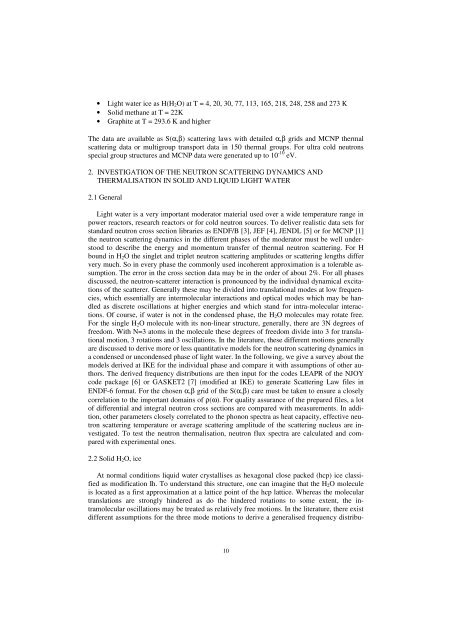Druck-Materie 20b.qxd - JUWEL - Forschungszentrum Jülich
Druck-Materie 20b.qxd - JUWEL - Forschungszentrum Jülich
Druck-Materie 20b.qxd - JUWEL - Forschungszentrum Jülich
Create successful ePaper yourself
Turn your PDF publications into a flip-book with our unique Google optimized e-Paper software.
• Light water ice as H(H2O) at T = 4, 20, 30, 77, 113, 165, 218, 248, 258 and 273 K<br />
• Solid methane at T = 22K<br />
• Graphite at T = 293.6 K and higher<br />
The data are available as S(α,β) scattering laws with detailed α,β grids and MCNP thermal<br />
scattering data or multigroup transport data in 150 thermal groups. For ultra cold neutrons<br />
special group structures and MCNP data were generated up to 10 -10 eV.<br />
2. INVESTIGATION OF THE NEUTRON SCATTERING DYNAMICS AND<br />
THERMALISATION IN SOLID AND LIQUID LIGHT WATER<br />
2.1 General<br />
Light water is a very important moderator material used over a wide temperature range in<br />
power reactors, research reactors or for cold neutron sources. To deliver realistic data sets for<br />
standard neutron cross section libraries as ENDF/B [3], JEF [4], JENDL [5] or for MCNP [1]<br />
the neutron scattering dynamics in the different phases of the moderator must be well understood<br />
to describe the energy and momentum transfer of thermal neutron scattering. For H<br />
bound in H2O the singlet and triplet neutron scattering amplitudes or scattering lengths differ<br />
very much. So in every phase the commonly used incoherent approximation is a tolerable assumption.<br />
The error in the cross section data may be in the order of about 2%. For all phases<br />
discussed, the neutron-scatterer interaction is pronounced by the individual dynamical excitations<br />
of the scatterer. Generally these may be divided into translational modes at low frequencies,<br />
which essentially are intermolecular interactions and optical modes which may be handled<br />
as discrete oscillations at higher energies and which stand for intra-molecular interactions.<br />
Of course, if water is not in the condensed phase, the H2O molecules may rotate free.<br />
For the single H2O molecule with its non-linear structure, generally, there are 3N degrees of<br />
freedom. With N=3 atoms in the molecule these degrees of freedom divide into 3 for translational<br />
motion, 3 rotations and 3 oscillations. In the literature, these different motions generally<br />
are discussed to derive more or less quantitative models for the neutron scattering dynamics in<br />
a condensed or uncondensed phase of light water. In the following, we give a survey about the<br />
models derived at IKE for the individual phase and compare it with assumptions of other authors.<br />
The derived frequency distributions are then input for the codes LEAPR of the NJOY<br />
code package [6] or GASKET2 [7] (modified at IKE) to generate Scattering Law files in<br />
ENDF-6 format. For the chosen α,β grid of the S(α,β) care must be taken to ensure a closely<br />
correlation to the important domains of ρ(ω). For quality assurance of the prepared files, a lot<br />
of differential and integral neutron cross sections are compared with measurements. In addition,<br />
other parameters closely correlated to the phonon spectra as heat capacity, effective neutron<br />
scattering temperature or average scattering amplitude of the scattering nucleus are investigated.<br />
To test the neutron thermalisation, neutron flux spectra are calculated and compared<br />
with experimental ones.<br />
2.2 Solid H2O, ice<br />
At normal conditions liquid water crystallises as hexagonal close packed (hcp) ice classified<br />
as modification Ih. To understand this structure, one can imagine that the H2O molecule<br />
is located as a first approximation at a lattice point of the hcp lattice. Whereas the molecular<br />
translations are strongly hindered as do the hindered rotations to some extent, the intramolecular<br />
oscillations may be treated as relatively free motions. In the literature, there exist<br />
different assumptions for the three mode motions to derive a generalised frequency distribu-<br />
10

















